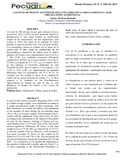Mostrar el registro sencillo del ítem
Ganancia de peso en alevines de pez gato africano (clarias gariepinus), bajo tres raciones alimenticias
| dc.rights.license | http://creativecommons.org/licenses/by-nc-sa/3.0/ve/ | |
| dc.contributor.author | Perdomo Redondo, Loreley Rita | |
| dc.date.accessioned | 2013-10-25T14:13:34Z | |
| dc.date.available | 2013-10-25T14:13:34Z | |
| dc.date.issued | 2013-10-25T14:13:34Z | |
| dc.identifier.issn | 1856-111X | |
| dc.identifier.uri | http://www.saber.ula.ve/handle/123456789/37698 | |
| dc.description.abstract | Un total de 180 alevines de pez gato africano (Clarias gariepinus) (20.0 + 0.09 g de peso promedio inicial) se distribuyeron al azar según modelo de clasificación simple en tres tratamientos con tres repeticiones, para evaluar el efecto del ajuste de la cantidad de ración durante la etapa de preceba (20 a 150 g de peso medio). Los tratamientos fueron un control con el ajuste de la ración cada 30 días, según las orientaciones de los Procedimientos Operativos de trabajo para el cultivo intensivo de Clarias y dos experimentales cada 15 (T-I) y 7 días (T-II). Los resultados mostraron diferencias significativas (P<0,01) en los pesos finales a favor de T-II (186,3 g) seguido de T-I (172,1 g) y el control (156,6 g). Sin embargo, la conversión alimentaria fue más favorable (P<0,01) para el control (1,12) respecto a T-I (1,53) y T-II (1.36). La supervivencia no presentó diferencias entre los tratamientos (90, 93 y 90 %). Se concluyó que fue factible el ajuste de la cantidad de ración con un menor intervalo de tiempo (7 o 15 días) respecto a lo orientado en los Procedimientos Operacionales de Trabajo de cada 30 días, lo cual disminuye el tiempo de cultivo y los costos de producción. | es_VE |
| dc.language.iso | es | es_VE |
| dc.rights | info:eu-repo/semantics/openAccess | |
| dc.subject | Alimentación | es_VE |
| dc.subject | Clarias | es_VE |
| dc.subject | Ajuste de ración | es_VE |
| dc.title | Ganancia de peso en alevines de pez gato africano (clarias gariepinus), bajo tres raciones alimenticias | es_VE |
| dc.type | info:eu-repo/semantics/article | |
| dc.description.abstract1 | A total of 180 Clarias gariepinus fingerling (20.0 + 0.09 g of initial average weight) were distributed according to a simple classification model in three treatments with three repetitions, to evaluate the effect of the adjustment of the quantity of ration during the pre-fattening stage (20 to 150 g of average weight). The treatments were a control with the adjustment of the ration every 30 days, according to the orientations of the Operative Procedures of work for the intensive farming of Clarias and two experimental every 15 (T-I) and 7 days (T-II). The results showed significant differences (P <0,01) in the final weight in favor of T-II (186.3 g) followed by T-I (172.1 g) and the control (156.6 g). However, food conversion was more favorable (P <0,01) for the control (1.12) respect to T-I (1.53) and T-II (1.36). The survivance did not present differences among the treatments (90, 93 and 90%). As a conclusion, it was feasible the adjustment of the quantity of ration with a smaller interval of time (7 or 15 days) regarding to the Operational Procedures of Work every 30 days, which it decreases the time of cultivation and the production costs. | es_VE |
| dc.description.colacion | 140-142 | es_VE |
| dc.description.email | ccvmayabeque@infomed.sld.cu | es_VE |
| dc.identifier.depositolegal | 200502MEI822 | |
| dc.subject.facultad | Núcleo Rafael Rangel (NURR) | es_VE |
| dc.subject.keywords | Adjustment of ration | es_VE |
| dc.subject.keywords | Feeding | es_VE |
| dc.subject.publicacionelectronica | Revista Mundo Pecuario | |
| dc.subject.seccion | Revista Mundo Pecuario: Artículos | es_VE |
| dc.subject.tipo | Revistas | es_VE |
| dc.type.media | Texto | es_VE |
Ficheros en el ítem
Este ítem aparece en la(s) siguiente(s) colección(ones)
-
Mundo Pecuario - Vol. 009 - Nº 3
Septiembre - Diciembre 2013


